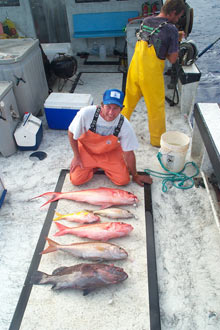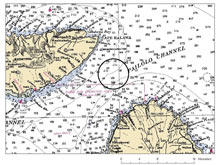Figure 1. These fish represent six of the major Hawaiian bottomfish species. They are shown here with the hydraulic reel (upper right) cruise members used to catch them. Click image for larger view and image credit.
Hawaiian Bottomfish Communities
Christopher KelleyProgram Biologist
Hawaii Undersea Research Laboratories
The most important members of the Main Hawaiian Islands (MHI) bottomfish fishery are six deep-water snappers (family Lutjanidae) and one deep-water grouper (family Serranidae). All are active swimmers (fig. 1) and are called "bottomfish," not because they sit on the bottom but because they aggregate over certain types of bottom, particularly steep, rocky terrain. Another reason is that they’re caught with bottomfishing gear (i.e., a weighted hook and line), not by trolling or trawling. All seven of these species live well below scuba depths, which makes both catching these fish and managing this fishery quite difficult. Fishers must have specialized equipment such as global positioning satellite (GPS) receivers on their boats as well as hydraulic or electric reels, heavy weights (4 to 6 lbs), special line, and multiple branching hooks. Offshore weather and sea conditions often can be poor, forcing them to endure 20 to 25 mi-per-hr winds and 6 to 10 ft seas.
Managing this fishery is difficult because their habitat is not well studied or understood. With so little information, the federally designated essential fish habitat (EFH) for the fishery is defined as the 100-to-400 m depth range around each island and bank, which is simply too general. The problem is that most of this zone is sand or mud, where there aren’t any fish. Only in the last couple of years have sophisticated multibeam sonar surveys been carried out that allow state and federal fisheries managers to see and measure the sizes of actual rocky habitat sites within the EFH. Even so, managers still don’t know how many fish should be taken from a particular habitat of a particular size, and right now too many fish are indeed being caught. The Secretary of Commerce recently determined that the MHI bottomfish fishery is in a “state of overfishing.” If this continues for very long, the fishery could be in real trouble down the road.
Bottomfish habitats are found in both state waters (i.e., 0 to 3 mi out from shore) and federal waters (3 to 12 mi from shore), which further complicates the management of this fishery. State waters generally hold more of the habitats, and state managers from the Hawaii Division of Aquatic Resources (HDAR) have been addressing the problem with a “closed area” rather than a “closed season” approach. In 1998, the state created 19 restricted fishing areas (RFAs) where bottomfishing was prohibited. The RFAs are a type of marine protected area (MPA) and are spread throughout the main islands, protecting an approximated 7.5% of the estimated 5,700-sq-km bottomfish EFH. In May 2005, various indicators suggested that the RFAs were not significantly improving the fishery during the first 5 yrs of their creation. The multibeam sonar data coupled with fishing surveys indicated the problem was that the RFAs were not protecting enough of the rocky habitat within the EFH.
Instead of abandoning their approach, state managers decided to improve the system. After extensive analysis of the new habitat data, new RFAs were designed that are now being reviewed by both state and federal agencies. These areas not only protect more EFH, but more preferred habitat within the EFH than the old areas. They furthermore take into account sensitive locations, such as potential nursery grounds and deep-water coral beds, that could be impacted by anchors and bottomfishing gear. One new RFA is located in the Pailolo Channel between the Islands of Molokai and Maui and is believed to be a particularly sensitive site (fig. 2). The habitat here seems to have not only juvenile bottomfish but also numerous coral colonies, sponges, and many other invertebrates (fig. 3). However, this is based on only one Pisces V submersible dive so clearly a more comprehensive assessment needs to be carried out. That is the intent of the laser line scanner survey. The scanner will be deployed for two days on this site to obtain images of the substrate, the benthic (sea bottom) fauna, particularly deep-water corals, and bottomfish juveniles. If successful, this instrument may prove to be a very valuable tool for assessing other bottomfish habitats in Hawaii and elsewhere in the Pacific.
















